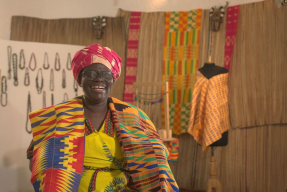By Allison Moomey, KF16, Burkina Faso
The longer I’m with my partner microfinance institution, Micro Start, the more impressed I am with them. Not only are they wonderful, hard-working people who get things done, but they also have a long-term, sustainable, and empowering vision. I recently completed a credit and savings product survey, and one of the questions for each product is “what is the goal of this product?” The answer always involved the word autonome, or autonomous. Each product is working to eventually move the client to financial stability and independence.
Given the lack of financial history for most new clients, Micro Start recognizes that most aren’t yet ready to make the giant leap to complete financial independence. There’s where the “ladder of autonomy” comes in. Although not an official name, the image of a ladder helps to illustrate the path Micro Start clients take. The idea is essentially to start clients at a place where they are able to make small financial strides and move them to a place where these strides become larger and larger. This prevents over-indebtedness, which is a crucial to avoid for effective microfinance.
The first step on this ladder is a savings account directly at the market. This savings account requires the client to save a small amount each day (~ $0.40) until they reach the price of a good for their business. The most common product for which this account is used is gas for stoves. These clients have used wood for energy in the past, and they are looking for a way to switch over to gas. There are four significant advantages to this method:
- The client can purchase gas for cheaper at Micro Start than at a commercial vendor, as Micro Start’s goals are simply to cover the costs of their operation, not make a profit.
- Over the long term, gas is actually cheaper than wood, but it requires a much larger one-time investment, which is otherwise prohibitive for most clients.
- It facilitates borrower savings by requiring clients to deposit money each day before it ever leaves the market (for many cultural and economic reasons it is much harder to save this money once it gets home).
- The environment smiles when gas is used in place of wood.
After a client successfully completes this process, Micro Start can be confident in their ability to pay back a loan. For clients who are cannot access traditional financial services because they lack credit and collateral, this is a great way for Micro Start to establish trust in the client’s ability to save and pay back a loan. This is important not only for any institution to protect itself from excess risk but also for client protection from over-indebtedness. After obtaining their product, a consistent and responsible client can “graduate” to a solidarity group loan and move one rung up the ladder.
With a solidarity group loan, a client can gather a group of other women they trust and request a small loan from Micro Start. If their loan is approved, they will be on their way up in the world of microcredit. After they pay back this first small loan on time, many clients take out a new loan, often for a slightly larger amount. You will see many of these relistings posted on Kiva’s website. I met an ambitious client last month who was working hard to pay back her first loan ahead of time so she could take out another and continue to grow her business.

One of Micro Start's motivated clients who wanted to pay back quickly to take out another loan and continue to grow her business.
After a few loan cycles in a solidarity group, a client who has the desire and ability can take one more step up and become and individual client. As an individual, a client has more flexibility and freedom with their loan, and the loan is often for a larger amount. Clients can continue with numerous individual loan cycles and grow their business a bit more each time. Once they have enough income, capital, and credit history, the hope is that clients can reach the point where that they can now access traditional financial services. This access opens many previously closed doors and provides a level of autonomy previously inaccessible to these clients.
There’s no strict ladder or formula for a client’s climb up the ladder of autonomy. The exact path a client takes depends on numerous factors, but the map Micro Start has set out and implements is moving clients in a direction of empowerment. And that’s the beauty of microfinance!
Allison Moomey is a Kiva Fellow (KF 16) working with Micro Start in Ouagadougou, Burkina Faso. To learn more, please visit Micro Start’s partner page, join the Friends of Micro Start/AFD lending team, and lend to Burkinabe borrowers.
PREVIOUS ARTICLE
Continuing to Think Outside the Box →NEXT ARTICLE
NFS Series: Women's Empowerment Part 1: Economic Empowerment →















